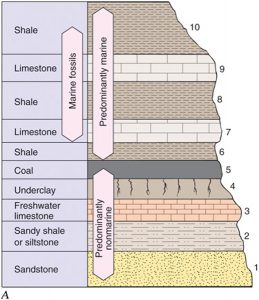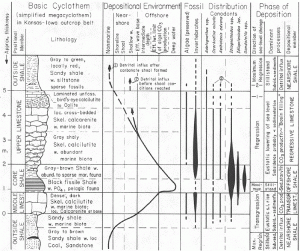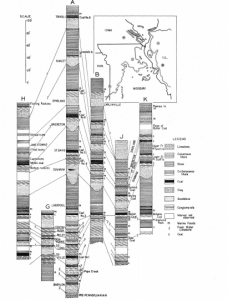

Now that some background information has been given, one who is not familiar with geology should be able to understand Wanless’ biggest geologic contribution. Cyclothem is derived from two Greek words: Oyclos, cycle, and thema, a deposit. Cyclothems are repetitive stratigraphic sequences that are unique to the Pennsylvanian and earliest Permian periods within the US midcontinent. They formed as a result of marine transgressions and regressions as explained in the previous paragraph. The ideal Midcontinent cyclothymic deposit consists of four basic units. A unit is a distinct layer of rock with the same composition. The first unit is a thin transgressive marine limestone. The second is a thin, offshore black shale, the third unit is a thicker shallowing-upward regressive limestone. The last unit is a nearshore to terrestrial non-carbonate unit like a sandstone or a paleosol (ancient soil). Wanless was the one to give these specific stratigraphic sequences a name. Cyclothems are significant because they can be used to date rocks and identify petroleum deposits.
Summary of Correlation and Extent of Pennsylvanian Cyclothems
This paper by Wanless and Weller was read before the Geological Society of America on December 29, 1931. Its general statement reads:
The heterogeneous strata of the Pennsylvanian system in the central and eastern states constitute a complex succession so different from the older Paleozoic systems that the  interpretation of the Pennsylvanian is difficult and few geologists have attempted more than a generalization of its geological history. Because of variable lithology and the generally long or unknown range of invertebrate fossils, these standard means of correlation have proved, up to this time, to be of negligible service, and the fossil plants, which are probably no more accurate stratigraphic indices than are the invertebrates, have furnished the basis for practically all previous correlations between the Pennsylvanian strata of the different basins or between remote portions of the same basin. (http://bulletin.geoscienceworld.org/content/abull/43/4/1003.full.pdf)
interpretation of the Pennsylvanian is difficult and few geologists have attempted more than a generalization of its geological history. Because of variable lithology and the generally long or unknown range of invertebrate fossils, these standard means of correlation have proved, up to this time, to be of negligible service, and the fossil plants, which are probably no more accurate stratigraphic indices than are the invertebrates, have furnished the basis for practically all previous correlations between the Pennsylvanian strata of the different basins or between remote portions of the same basin. (http://bulletin.geoscienceworld.org/content/abull/43/4/1003.full.pdf)
Wanless had a hypothesis in 1926 that the Pennsylvanian beds were compiled and consisted of repeated series of beds later termed cyclothems which are composed of a similar succession of units. These units are split into marine sediments and continental sediments. The marine sediments consist of shale with ironstone nodules and bands, limestone with marine fossils, and black sheety shale with large concretions. The continental sediments are coal, underclay, limestone without marine fossils, sandy shale, sandstone unconformable on lower beds. His hypothesis was the postulation that each of the cyclothems should be extensive in the sedimentary basin. If this were proved true, a new method of correlation would be made. Correlations would not be only dependent on key horizons or faunas, or floras, but also on cyclothymic successions.
Wanless went to the Alexis and Havana quadrangles of western IL and studied that strata exposed. His studies showed that the entire Pennsylvanian system in the eastern interior and the northern Appalachian basins consists of a similar succession of cyclothems. He also found that individual cyclothems are persistent and that correlation of cyclothems spans across widely separated localities. The cyclothems that Wanless studied in Illinois are varied within the whole state of IL. Due to this one can reason that beds can vary greatly with in a small area as well. Correlation
The conclusion of the paper states:
The remarkable similarity of the Lower Pennsylvanian strata on both sides of Mississippi River substantiates the postulation (1) that the Pennsylvanian strata in the various coal basins are but remnants of an originally continuous sedimentary blanket, (2) that the marine invasions which occurred periodically throughout the Pennsylvanian period were very extensive and connected the various basins in nearly every case, and (3) that the cyclical repetition of strata in the different basins was controlled by the same series of diastrophic movements which must have affected the entire eastern half of North America. Strictly, the evidence so far warrants these conclusions only for the Eastern and Western Interior basins, but inasmuch as the Pennsylvanian strata in the northern part of the Appalachian basin occur in a similar cyclical succession it may soon be possible to make precise correlations between that region and the Eastern Interior basin. The rudimentary cyclothems present an interesting problem unrecognized when the cyclical hypothesis was formulated. Their interpretation awaits further studies. (http://bulletin.geoscienceworld.org/content/abull/43/4/1003.full.pdf)
Sea Level and Climatic Changes Related to Late Paleozoic Cycles
Wanless wrote Sea Level and Climatic Changes Related to Late Paleozoic Cycles with Francis P. Shepard in 1936, five years after the publication of Correlation and Extent of Pennsylvanian Cyclothems. This purpose of the present paper is “to review the explanations of cyclic sedimentation that present the new hypothesis that the rhythmic alternations of sediment in the late Paleozoic are controlled largely by sea level fluctuations and climatic variations related to late Paleozoic glaciation.” The paper then goes over three hypothesis listed below:
Hypothesis of Intermittent Subsidence
The Hypothesis of intermittent subsidence states that the cyclic sediments as records of periodic regional subsidence of the basin of deposition after the formation of the coal beds, the subsidence being checked after the limestone and shale had been formed over the coal. The sandstone and sandy shale were then thought to have filled the basin gradually until the formation of the underclay of the next coal, when it was again above sea level. This was followed by coal deposition and renewed subsidence. The subsiding basin may have become filled with sediment up to sea level by the time shale deposition ceased, and the overlying disconformable sandstone may have accumulated under nonmarine conditions.
Hypothesis of Alternate Subsidence and Uplift
Hypothesis of a succession of diastrophic states that stream valleys were cut across the newly exposed sediment, then gradual subsidence of the depositional basin effected a filling of the channels with sand or silt. With more marked subsidence of the source area, less and less sediment was brought into the adjacent basins, which led to a stable surface slightly above the water table. This was altered by soil-forming processes which produced an underclay. With further subsidence, a coal swamp developed above.
Hypothesis of Sea-Level Fluctuations
The hypothesis of sea-level fluctuations states that the emergence and submergence of a land mass may be due either to movements of the land or to changes of sea level. Earth movements might be inadequate to explain the peculiar sedimentary cycles. Sedimentary cycles in the Pennsylvanian strata.
Summary and Conclusion
Cyclothems characterize the stratigraphy of most of the well-studied sections of late Mississippian, Pennsylvanian, and early Permian ages in Europe and North America. The sequences were interpreted by the hypothesis of alternate advances and retreats of the seas, and contemporary fluctuations in climate. The period of time recorded by these cyclic sediments is due to widespread glaciation, especially in the southern hemisphere. The paper states “This glaciation must have lowered the sea level, and caused the temporary withdrawal of waters from large portions of shallow interior seas.” (http://bulletin.geoscienceworld.org/content/abull/47/8/1177.full.pdf)
The unconformities and non-marine sediments in the cyclic successions were interpreted as recording these periods of sea withdrawal and glacial maxima. Variations in sedimentation in non-marine sequences were interpreted as recording variations in temperature and humidity. The hypothesis of glacially-controlled sea level oscillations appeared more satisfactory as an explanation of the cycles than previously developed diastrophic hypotheses. This is due to widespread cyclic sedimentation in late Paleozoic rocks, the great extent of individual strata, and because of the complicated diastrophic hypothesis which would be required to explain these successions. The paper concludes with:
On the other hand local diastrophism was important and the depositional basins are thought to have subsided slowly as sediment accumulated, the cyclic fluctuation being due to the rise and fall of sea level during this settling. The kind and quantity of sediment are believed to indicate the nearness to the source of sediment, the character of local physiography, and the general climate of the area. (http://bulletin.geoscienceworld.org/content/abull/47/8/1177.full.pdf)

